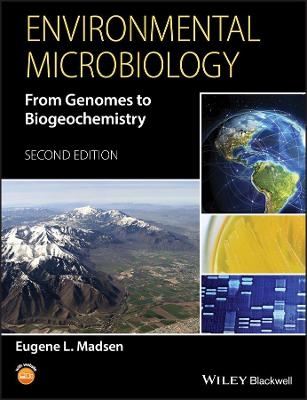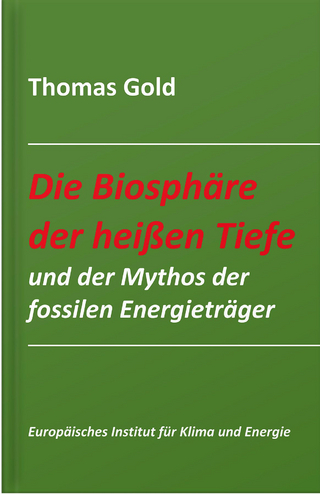
Environmental Microbiology
Wiley-Blackwell (Verlag)
978-1-118-43963-0 (ISBN)
New and expanded for its second edition, Environmental Microbiology: From Genomes to Biogeochemistry¸ Second Edition, is a timely update to a classic text filled with ideas, connections, and concepts that advance an in-depth understanding of this growing segment of microbiology. Core principles are highlighted with an emphasis on the logic of the science and new methods-driven discoveries. Numerous up-to-date examples and applications boxes provide tangible reinforcement of material covered. Study questions at the end of each chapter require students to utilize analytical and quantitative approaches, to define and defend arguments, and to apply microbiological paradigms to their personal interests. Essay assignments and related readings stimulate student inquiry and serve as focal points for teachers to launch classroom discussions. A companion website with downloadable artwork and answers to study questions is also available.
Environmental Microbiology: From Genomes to Biogeochemistry, Second Edition, offers a coherent and comprehensive treatment of this dynamic, emerging field, building bridges between basic biology, evolution, genomics, ecology, biotechnology, climate change, and the environmental sciences.
About the Author Eugene L. Madsen is a Professor in the Department of Microbiology at Cornell University, Ithaca, New York, USA.
Preface viii
About the Companion Website x
1 Significance, History, and Challenges of Environmental Microbiology 1
1.1 Core concepts can unify environmental microbiology 1
1.2 Synopsis of the significance of environmental microbiology 2
1.3 A brief history of environmental microbiology 6
1.4 Complexity of our world 10
1.5 Many disciplines and their integration 13
2 Formation of the Biosphere: Key Biogeochemical and Evolutionary Events 25
2.1 Issues and methods in Earth’s history and evolution 26
2.2 Formation of early planet Earth 26
2.3 Did life reach Earth from Mars? 30
2.4 Plausible stages in the development of early life 31
2.5 Mineral surfaces in marine hydrothermal vents: the early iron/sulphur world could have driven biosynthesis 35
2.6 Encapsulation (a key to cellular life) and an alternative (nonmarine) hypothesis for the habitat of precellular life 36
2.7 A plausible definition of the tree of life’s “Last universal common ancestor” (LUCA) 37
2.8 The rise of oxygen 39
2.9 Evidence for oxygen and cellular life in the sedimentary record 39
2.10 The evolution of oxygenic photosynthesis 42
2.11 Consequences of oxygenic photosynthesis: molecular oxygen in the atmosphere and large pools of organic carbon 45
2.12 Eukaryotic evolution: endosymbiotic theory and the blending of traits from Archaea and Bacteria 48
3 Physiological Ecology: Resource Exploitation by Microorganisms 56
3.1 The cause of physiological diversity: diverse habitats provide selective pressures over evolutionary time 57
3.2 Biological and evolutionary insights from genomics 57
3.3 Fundamentals of nutrition: carbon- and energy-source utilization provide a foundation for physiological ecology 69
3.4 Selective pressures: ecosystem nutrient fluxes regulate the physiological status and composition of microbial communities 71
3.5 Cellular responses to starvation: resting stages, environmental sensing circuits, gene regulation, dormancy, and slow growth 76
3.6 A planet of complex mixtures in chemical disequilibrium 86
3.7 A thermodynamic hierarchy describing biosphere selective pressures, energy sources, and biogeochemical reactions 91
3.8 Using the thermodynamic hierarchy of half reactions to predict biogeochemical reactions in time and space 93
3.9 Overview of metabolism and the “logic of electron transport” 104
3.10 The flow of carbon and electrons in anaerobic food chains: syntrophy is the rule 105
3.11 The diversity of lithotrophic reactions 109
4 A Survey of the Earth’s Microbial Habitats 117
4.1 Terrestrial biomes 118
4.2 Soils: geographic features relevant to both vegetation and microorganisms 120
4.3 Aquatic habitats 124
4.4 Subsurface habitats: oceanic and terrestrial 131
4.5 Defining the prokaryotic biosphere: where do prokaryotes occur on Earth? 141
4.6 Life at the micron scale: an excursion into the microhabitat of soil microorganisms 145
4.7 Extreme habitats for life and microbiological adaptations 151
5 Microbial Diversity: Who is Here and How do we Know? 162
5.1 Defining cultured and uncultured microorganisms 163
5.2 Approaching a census: an introduction to the environmental microbiological “toolbox” 167
5.3 Criteria for census taking: recognition of distinctive microorganisms (species) 170
5.4 Proceeding toward census taking and measures of microbial diversity 175
5.5 The tree of life: our view of evolution’s blueprint for biological diversity 181
5.6 A Sampling of key traits of cultured microorganisms from the domains Eukarya, Bacteria, and Archaea 185
5.7 Placing the “uncultured majority” on the tree of life: what have nonculture-based investigations revealed? 205
5.8 Viruses: an overview of biology, ecology, and diversity 213
5.9 Microbial diversity illustrated by genomics, horizontal gene transfer, and cell size 220
5.10 Biogeography of microorganisms 224
6 Generating and Interpreting Information in Environmental Microbiology: Methods and Their Limitations 238
6.1 How do we know? 239
6.2 Perspectives from a century of scholars and enrichment-cultivation procedures 239
6.3 Constraints on knowledge imposed by ecosystem complexity 243
6.4 Environmental microbiology’s “Heisenberg uncertainty principle”: model systems and their risks 245
6.5 Fieldwork: being sure sampling procedures are compatible with analyses and goals 247
6.6 Blending and balancing disciplines from field geochemistry to pure cultures 253
6.7 Overview of methods for determining the position and composition of microbial communities 257
6.8 Methods for determining in situ biogeochemical activities and when they occur 276
6.9 Cloning-based Metagenomics and related methods: procedures and insights 280
6.10 cloning-free, next-generation sequencing and omics methods: procedures and insights 290
6.11 Discovering the organisms responsible for particular ecological processes: linking identity with activity 325
7 Microbial Biogeochemistry: A Grand Synthesis 356
7.1 Mineral connections: the roles of inorganic elements in life processes 357
7.2 Greenhouse gases and lessons from biogeochemical modeling 361
7.3 The “stuff of life”: identifying the pools of biosphere materials whose microbiological transformations drive the biogeochemical cycles 372
7.4 Elemental biogeochemical cycles: concepts and physiological processes 393
7.5 Cellular mechanisms of microbial biogeochemical pathways 409
7.6 Mass balance approaches to elemental cycles 418
8 Special and Applied Topics in Environmental Microbiology 432
8.1 Other organisms as microbial habitats: ecological relationships 432
8.2 Microbial residents of plants and humans 449
8.3 Biodegradation and bioremediation 461
8.4 Biofilms 489
8.5 Evolution of catabolic pathways for organic contaminants 493
8.6 Environmental biotechnology: overview and nine case studies 499
8.7 Antibiotic resistance 514
9 Future Frontiers in Environmental Microbiology 538
9.1 The influence of systems biology on environmental microbiology 538
9.2 Ecological niches and their genetic basis 546
9.3 Concepts help define future progress in environmental microbiology 551
Glossary 557
Index 564
| Erscheint lt. Verlag | 18.9.2015 |
|---|---|
| Verlagsort | Hoboken |
| Sprache | englisch |
| Maße | 188 x 249 mm |
| Gewicht | 1315 g |
| Themenwelt | Naturwissenschaften ► Biologie ► Biochemie |
| Naturwissenschaften ► Biologie ► Mikrobiologie / Immunologie | |
| Naturwissenschaften ► Biologie ► Ökologie / Naturschutz | |
| ISBN-10 | 1-118-43963-5 / 1118439635 |
| ISBN-13 | 978-1-118-43963-0 / 9781118439630 |
| Zustand | Neuware |
| Informationen gemäß Produktsicherheitsverordnung (GPSR) | |
| Haben Sie eine Frage zum Produkt? |
aus dem Bereich


